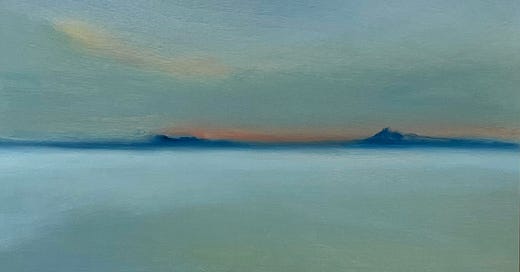In landscape painting, a simple horizontal line is all that’s needed to indicate a horizon. Placement of this line, no need for it to be geometrically accurate, helps establish the mood of the painting. If it is high in the frame, or very low, a feeling is evoked. The horizon can be far off, almost unattainable and beckoning, or close, and intimate. Details emphasize the mood the painter wants to suggest. The contrast between light and dark values direct our eye to the places the painter wants us to pause.
For the psyche, the horizontal line represents the here and now. This is the place where we live. While the vertical draws our eyes upward, toward the heavens, we must walk on earth and find our actual lives here. We are creatures of this earth, and although we aspire to transcend the finitude of our lives, reaching ever higher, it is this vast horizontal plane on which we conduct our many affairs.
Carl Jung offered an insightful analysis of the Christian cross. He pointed out that in earlier times, the intersect of the horizontal and vertical lines of the cross were practically equidistant. In fact, the cross was encircled as if it were the center of the sun. Slowly, through history, the horizontal line rose higher on the vertical one, so that the cross came to resemble the figure of a man with arms outstretched. The horizontal pole became high and narrow, and lost width. For Jung, this transformation suggested a move away from divinity to a cross depicting the state of human consciousness. With the horizontal pole high and narrow, and the vertical one extra tall, the message is one of aspiration but not of living life in the here and now. The importance of the here and now is diminished in favor of heaven, though of course this is paradoxical for those of us living.
References to directional lines are found everywhere in our speech, as if the psyche were spacial. Michelle Obama tells us to go high when others go low. An unsettled person might describe herself as upset; turned upside down from distress. A struggling student says he can’t reach an understanding. A solid person has two feet on the ground, or is grounded. There is elevation of thought in a high level conversation, or conversely, some need to be advised to get their minds out of the gutter. It is almost impossible for some of us to comprehend without translating ideas into spacial terms. Architects try to move beyond the conflict of corners by creating vast windows so that interiors are “open” and the person inside will feel safe but not contained. This contradiction, the desire to have safety without walls, or freedom without definition is the source of seemingly infinite creative effort as well as personal suffering.
Direction indicate meaning. When you think of North, what do you associate with it? I think of a beautiful austerity, sweeping cold winds and sturdy evergreens. Or with any of the other directions; the warmth of the South, the adventure of the West, the beginnings of the East… We map our minds out spatially, or perhaps, we internalize our minds whose true residence is everywhere.
In his book, On Having No Head, Douglas Harding relates his discovery that for actual experience, he has no head. Where his head should be there is instead the vastness of everything around him. If you look down right now, you will see your body, but not your head. I see my hands typing, but no head, only the the world that I am. For Harding, this is a direct demonstration of awakened consciousness. The literal truth of who you are is that you are everything.
In painting, with the wonderful language of vertical and horizontal, light and dark, color and space, we have the chance to directly communicate truths-wordlessly but oh so directly. I have noticed with my own work that I have trouble bringing in distinctive verticals. My inclination is to remove everything that is in the way and leave only emptiness. In my paintings, vertical lines can seem to have such a there-ness, as if they introduce the limit of a point of view. But if I remove color, line, form, how is it a painting? I am brought back again and again to the Buddhist teaching; Form is Emptiness, Emptiness is Form. And what does this look like? What does this feel like?
If you consider, for the life of spirit, the relation between the horizontal and vertical; between the here and now and aspiration, how do you see your own life? What would balance be-that is, the proper relation of the horizontal and vertical for your own life? Sometimes people seem top heavy. Their intellect out weighs their ability to do concrete things. Or a person might be a purity seeker; somehow trying to live only in aspiration. My own sense is that the best life is the life wherein the spiritual is experienced in the doings of everyday. There is no other, better life somewhere. Your best life is this one lived attentively.
I am going to my studio now to see if I can find out how a moment in my day holds all of time.
I am grateful to those of you who have chosen to become paid subscribers. I am also grateful to those of you to follow my newsletter and find it meaningful.
Namaste, Leslie





Leslie❤️such beautiful writing. Thank you. I live at similar intersections of art and soul and am a new painter. i’ll be following you.